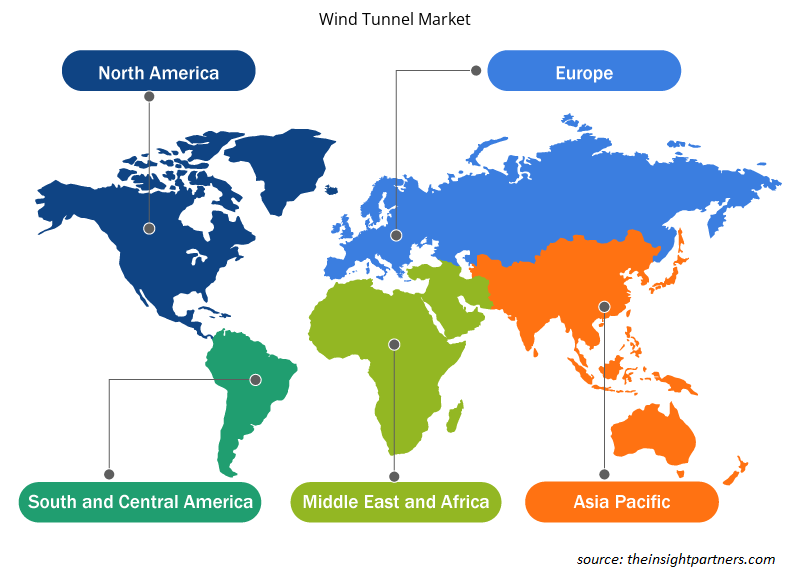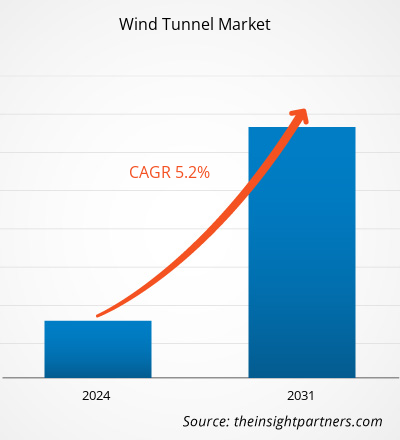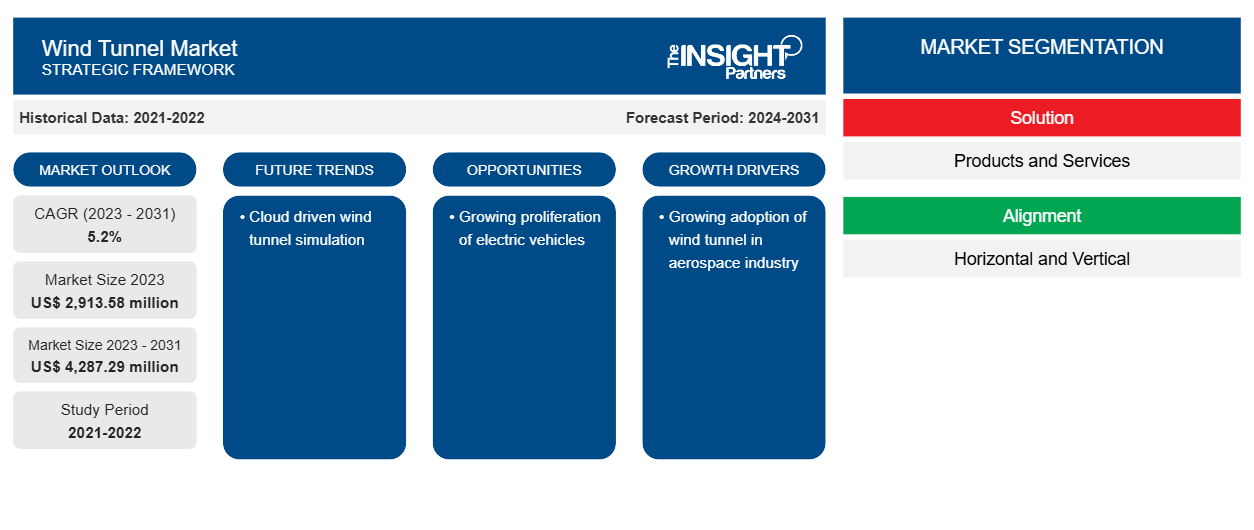Se proyecta que el tamaño del mercado de túneles de viento alcance los 4.287,29 millones de dólares estadounidenses en 2031, frente a los 2.913,58 millones de dólares estadounidenses en 2023. Se espera que el mercado registre una CAGR del 5,2 % durante el período 2023-2031. Es probable que el creciente desarrollo del sector de la construcción siga siendo una tendencia clave en el mercado.
Análisis del mercado de túneles de viento
Se prevé que la creciente inversión de los gobiernos para fortalecer las capacidades de fabricación en los países en desarrollo y las mejoras en los servicios de mantenimiento, junto con los avances en la tecnología de las instalaciones de prueba, impulsen la demanda de túneles de viento entre las industrias de uso final en los próximos años. Los usuarios finales de los túneles de viento son industrias de gran escala, como la automotriz y la aeroespacial, que influyen directamente en la dinámica del mercado. En la actualidad, el sector de vehículos eléctricos en la industria automotriz y los sectores de fabricación de vehículos aéreos no tripulados y aeronaves/misiles de defensa en la industria aeroespacial están impulsando el crecimiento del mercado.
Descripción general del mercado de túneles de viento
Se prevé que la creciente demanda de infraestructuras ecológicas y la creciente adopción de vehículos eléctricos impulsen la demanda del mercado de túneles de viento a nivel mundial. La creciente aplicación de túneles de viento en el sector aeroespacial está impulsando el crecimiento de este mercado a nivel mundial. El mercado está asociado a desafíos operativos y de alto costo que podrían obstaculizar el crecimiento. Sin embargo, se prevé que la creciente proliferación de simulaciones de túneles de viento impulsadas por la nube impulse el crecimiento del mercado de túneles de viento a nivel mundial.
Personalice este informe según sus necesidades
Obtendrá personalización en cualquier informe, sin cargo, incluidas partes de este informe o análisis a nivel de país, paquete de datos de Excel, así como también grandes ofertas y descuentos para empresas emergentes y universidades.
-
Obtenga las principales tendencias clave del mercado de este informe.Esta muestra GRATUITA incluirá análisis de datos, desde tendencias del mercado hasta estimaciones y pronósticos.
Factores impulsores y oportunidades del mercado de los túneles de viento
La creciente proliferación de edificios ecológicos favorece el mercado
Se prevé que el creciente énfasis en los enfoques respetuosos con el medio ambiente y sostenibles en el sector de la construcción estimule el crecimiento del mercado de túneles de viento a nivel mundial. El túnel de viento puede identificar la velocidad del viento alrededor de la superficie del edificio. El impacto de la fuerza del viento en el edificio es crucial, específicamente en edificios de gran altura con grandes superficies expuestas al viento, en los que la estructura interna del edificio resiste las fuerzas resultantes. A pesar de la creciente adopción de la dinámica de fluidos computacional para pruebas estructurales debido a la computación más rápida, no se considera adecuada para el uso rutinario en el diseño estructural de edificios, ya que sus predicciones deben verificarse mediante experimentos. La evaluación del impacto de la fuerza del viento en edificios de gran altura , fábricas y puentes puede ayudar a los diseñadores de edificios a construir una estructura que resista eficientemente los efectos del viento. Por lo tanto, la creciente proliferación del mercado de la construcción ecológica está impulsando el crecimiento del mercado de túneles de viento.
Creciente demanda de vehículos eléctricos
La aerodinámica desempeña un papel importante en los coches eléctricos en comparación con los vehículos con motor de combustión interna, ya que el mayor consumo de energía para acelerar o conducir cuesta arriba se puede recuperar mediante la recuperación de energía. Para gestionar las necesidades de recuperación de energía, los ingenieros automotrices realizan un análisis aerodinámico de un coche de pasajeros eléctrico utilizando túneles de viento. Los túneles de viento realizan las pruebas aerodinámicas principales de un vehículo eléctrico. Se prevé que el creciente énfasis en la mitigación de la contaminación ambiental y la creciente tendencia a la adopción de vehículos eléctricos de pasajeros ofrezcan oportunidades positivas para el mercado de los túneles de viento.
Informe de mercado de túneles de viento Análisis de segmentación
Los segmentos clave que contribuyeron a la derivación del análisis del mercado de túneles de viento son la solución, la alineación,tipo de velocidad del aire y aplicación.
- En función de la solución, el mercado de túneles de viento se divide en productos y servicios. El segmento de servicios tuvo una mayor participación de mercado en 2023.
- Por alineación, el mercado se segmenta en horizontal y vertical. El segmento horizontal tuvo una mayor participación de mercado en 2023.
- En términos de tipo de velocidad aerodinámica, el mercado se divide en subsónico, supersónico, transónico e hipersónico. El segmento subsónico tuvo una participación significativa del mercado en 2023.
- En términos de aplicación, el mercado está segmentado en aeroespacial y defensa, automoción y transporte, construcción de edificios y energía eólica, formación y simulación, paracaidismo deportivo de aventura y otros. El segmento aeroespacial y de defensa tuvo una participación significativa del mercado en 2023.
Análisis de la cuota de mercado de los túneles de viento por geografía
El alcance geográfico del informe del mercado del túnel de viento se divide principalmente en cinco regiones: América del Norte, Asia Pacífico, Europa, Medio Oriente y África, y América del Sur y Central.
Europe is leading the market. The growing application of wind tunnels in the aerospace and defense sector is boosting the growth of the wind tunnel market in Europe. There are various kinds of wind tunnels, each with its own features and speed range. Research centers and labs for aircraft construction and design are highly leveraging wind tunnels. In addition, the growing application of subsonic wind tunnels in the aerospace sector is also having a positive impact on the growth of the wind tunnel market in the region. The high presence of wind tunnel products and service providers in the region is also acting as a major driver for the wind tunnel market in Europe.
Wind Tunnel Market Regional Insights
The regional trends and factors influencing the Wind Tunnel Market throughout the forecast period have been thoroughly explained by the analysts at Insight Partners. This section also discusses Wind Tunnel Market segments and geography across North America, Europe, Asia Pacific, Middle East and Africa, and South and Central America.

- Get the Regional Specific Data for Wind Tunnel Market
Wind Tunnel Market Report Scope
| Report Attribute | Details |
|---|---|
| Market size in 2023 | US$ 2,913.58 million |
| Market Size by 2031 | US$ 4,287.29 million |
| Global CAGR (2023 - 2031) | 5.2% |
| Historical Data | 2021-2022 |
| Forecast period | 2024-2031 |
| Segments Covered |
By Solution
|
| Regions and Countries Covered |
North America
|
| Market leaders and key company profiles |
|
Market Players Density: Understanding Its Impact on Business Dynamics
The Wind Tunnel Market market is growing rapidly, driven by increasing end-user demand due to factors such as evolving consumer preferences, technological advancements, and greater awareness of the product's benefits. As demand rises, businesses are expanding their offerings, innovating to meet consumer needs, and capitalizing on emerging trends, which further fuels market growth.
Market players density refers to the distribution of firms or companies operating within a particular market or industry. It indicates how many competitors (market players) are present in a given market space relative to its size or total market value.
Major Companies operating in the Wind Tunnel Market are:
- Aerolab
- Aiolos
- The Boeing Company
- ETW GmbH
- Horiba Ltd
- Lockheed Martin Corporation
Descargo de responsabilidad : Las empresas enumeradas anteriormente no están clasificadas en ningún orden particular.

- Obtenga una descripción general de los principales actores clave del mercado de túneles de viento
Noticias y desarrollos recientes del mercado de túneles de viento
El mercado de túneles de viento se evalúa mediante la recopilación de datos cualitativos y cuantitativos a partir de una investigación primaria y secundaria, que incluye importantes publicaciones corporativas, datos de asociaciones y bases de datos. A continuación, se enumeran algunos de los avances en el mercado de túneles de viento:
- El túnel de viento climático de MAHLE se vuelve eléctrico. MAHLE amplía la gama de servicios en las instalaciones de última generación de Stuttgart y permite probar los efectos de la carga rápida en baterías de iones de litio sensibles en una amplia gama de posibles condiciones climáticas. (Fuente: Grupo MAHLE, comunicado de prensa, febrero de 2023)
- El 4 de noviembre de 2021, la Universidad de Notre Dame y Lockheed Martin Corporation firmaron un acuerdo marco de investigación para facilitar colaboraciones futuras que impulsen la investigación aeroespacial. Este acuerdo demuestra el deseo mutuo de ambas instituciones de acelerar su relación productiva en curso. (Fuente: Lockheed Martin Corporation, comunicado de prensa, noviembre de 2021)
Informe de mercado sobre túneles de viento: cobertura y resultados
El informe “Tamaño y pronóstico del mercado de túneles de viento (2021-2031)” proporciona un análisis detallado del mercado que cubre las siguientes áreas:
- Tamaño del mercado de túneles de viento y pronóstico a nivel global, regional y nacional para todos los segmentos clave del mercado cubiertos bajo el alcance
- Tendencias del mercado de túneles de viento, así como dinámicas del mercado, como impulsores, restricciones y oportunidades clave
- Análisis PEST y FODA detallados
- Análisis del mercado de túneles de viento que cubre las tendencias clave del mercado, el marco global y regional, los principales actores, las regulaciones y los desarrollos recientes del mercado.
- Análisis del panorama de la industria y de la competencia que abarca la concentración del mercado, el análisis de mapas de calor, los actores destacados y los desarrollos recientes del mercado de túneles de viento
- Perfiles detallados de empresas
- Análisis histórico (2 años), año base, pronóstico (7 años) con CAGR
- Análisis PEST y FODA
- Tamaño del mercado, valor/volumen: global, regional y nacional
- Industria y panorama competitivo
- Conjunto de datos de Excel
Informes recientes
Informes relacionados
Testimonios
Razón para comprar
- Toma de decisiones informada
- Comprensión de la dinámica del mercado
- Análisis competitivo
- Información sobre clientes
- Pronósticos del mercado
- Mitigación de riesgos
- Planificación estratégica
- Justificación de la inversión
- Identificación de mercados emergentes
- Mejora de las estrategias de marketing
- Impulso de la eficiencia operativa
- Alineación con las tendencias regulatorias























 Obtenga una muestra gratuita para - Mercado de túneles de viento
Obtenga una muestra gratuita para - Mercado de túneles de viento